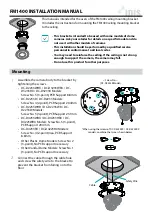
142
Operation
Chapter 4 - Operation and Administration
¯
Any number of L2 and/or VoIP Service Profiles may share the same VPL ID,
provided they all use the same Forwarding Rule.
¯
Any number of PPPoE Service Profiles may share the same VPL ID,
provided they all use the same Forwarding Rule.
¯
Any number of L2, VoIP and PPPoE Service Profiles may share the same
VPL ID, provided that all L2/Voice Service Profiles use the same
Forwarding Rule A, and all PPPoE Service Profiles use the same Forwarding
Rule B, where A and B are different.
The VLAN Transparency Mode defines the method of transferring packets to the
operator's upstream network. When set to On, data packets sent from the Base
Station to the backbone will be transferred transparently. The VPL ID parameter
is not applicable to Service Profiles with VLAN Transparency Mode On.
¢
For tagged packets, the VPL ID will be their VLAN tag.
¢
For untagged packets, the VPL ID will be None.
For packets received from the network, the forwarding decision will be according
to the packet's VPL ID. If the VPL ID is unknown (either None or not included in
the list of VPL IDs defined for any of the existing, non-transparent Service
Profiles), the system will assume this is a transparent VLAN packet (if at least one
transparent Service is defined) and transfer it with the original VLAN tag (or
untagged if there is no VLAN tag).
For transparent services, VLAN Classification Mode can be set to On to enable
downlink classification based on both the MAC Address and VLAN ID, to support
applications with multiple VLAN IDs per a single MAC address. All Services
assigned to the same SU must be configured with the same VLAN Classification
Mode (Either On or Off). If VLAN Classification Mode is On, only a single VLAN ID
can be defined for the Service. This means that the allowed combinations are:
¢
Hybrid VLAN Mode is Off and the VLAN List includes a single VLAN ID.
¢
Hybrid VLAN Mode is On and the VLAN List is empty.
For transparent services it is also possible to configure an Access VLAN to be used
with untagged packets received on the Ethernet port of the SU. This parameter is
applicable only for a transparent service with Hybrid Mode set to On, or a
transparent service with Hybrid Mode set to Off and an empty VLAN list.
A maximum of one Access VLAN can be defined per SU.
Содержание WiLink-I 3000
Страница 1: ...System Manual WiLink I Modular Base Station SW Version 2 5 June 2006 ...
Страница 16: ......
Страница 20: ......
Страница 24: ...4 System Description Chapter 1 System Description Figure 1 1 WiLink I System Architecture ...
Страница 42: ......
Страница 74: ......
Страница 214: ......
Страница 240: ......
















































